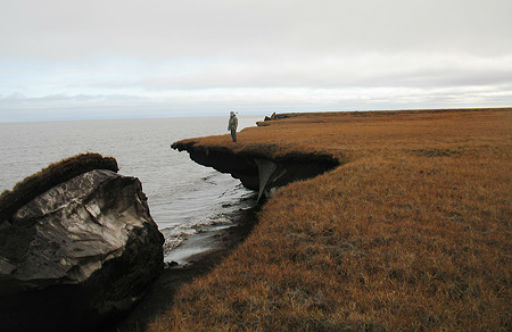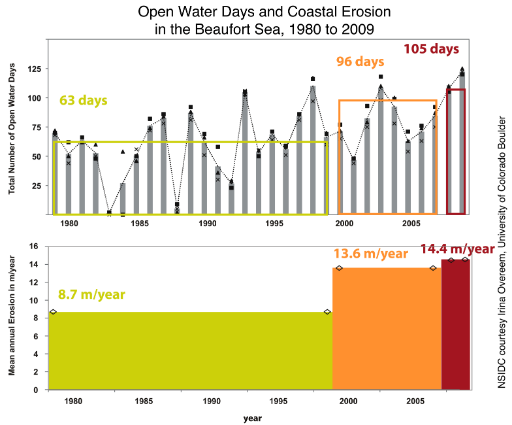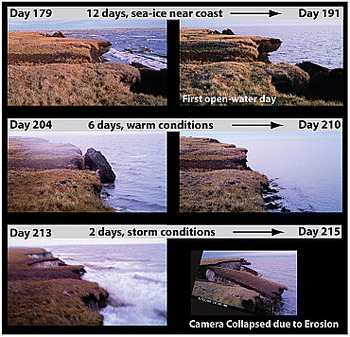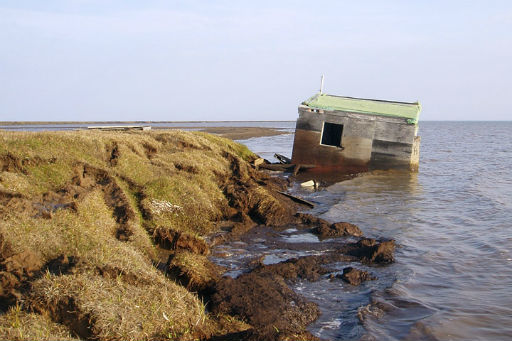Sea ice loss and coastal erosion

Declining sea ice in the Arctic has led to increasing erosion rates along the coast of the Beaufort Sea over the past fifty years, according to a new study led by Irina Overeem of the University of Colorado Institute for Arctic and Alpine Research (INSTAAR). Their study used a wave model driven by sea ice position and wind data causing coastal erosion.
As the period of open water on the coast of the Beaufort Sea has increased, so has the mean annual erosion rate, the study showed. From 1979 to 1999, the average erosion rate was 8.5 meters (27.9 feet) per year. The average rate over the period 2000 to 2007 was 13.6 meters (44.6 feet) per year, while the rate for the last two years of the record, 2008 to 2009, was 14.4 meters (47.2 feet) per year.

With a longer open water season, ocean water warms more and waves eat away at the coastline. The sediments comprising the coastal bluffs are locked together by permafrost—hard frozen ground with a concrete-like consistency. As the waves lap at the permafrost, they also help to thaw it, making the ground much more vulnerable to erosion. (NSIDC)
- Arctic coastal erosion along permafrost bluffs is 14m per year
- Exposure of permafrost bluffs to seawater increased 250% over 1979–2009
- Erosion is more rapid when sea ice free season expands into the early summer
 Erosion rates of permafrost coasts along the Beaufort Sea accelerated over the past 50 years synchronously with Arctic-wide declines in sea ice extent, suggesting a causal relationship between the two. A fetch-limited wave model driven by sea ice position and local wind data from northern Alaska indicates that the exposure of permafrost bluffs to seawater increased by a factor of 2.5 during 1979–2009. The duration of the open water season expanded from ∼45 days to ∼95 days. Open water expanded more rapidly toward the fall (∼0.92 day yr−1), when sea surface temperatures are cooler, than into the mid-summer (∼0.71 days yr−1).Time-lapse imagery demonstrates the relatively efficient erosive action of a single storm in August. Sea surface temperatures have already decreased significantly by fall, reducing the potential impact of thermal erosion due to fall season storm waves. (GLR/AGU)
Erosion rates of permafrost coasts along the Beaufort Sea accelerated over the past 50 years synchronously with Arctic-wide declines in sea ice extent, suggesting a causal relationship between the two. A fetch-limited wave model driven by sea ice position and local wind data from northern Alaska indicates that the exposure of permafrost bluffs to seawater increased by a factor of 2.5 during 1979–2009. The duration of the open water season expanded from ∼45 days to ∼95 days. Open water expanded more rapidly toward the fall (∼0.92 day yr−1), when sea surface temperatures are cooler, than into the mid-summer (∼0.71 days yr−1).Time-lapse imagery demonstrates the relatively efficient erosive action of a single storm in August. Sea surface temperatures have already decreased significantly by fall, reducing the potential impact of thermal erosion due to fall season storm waves. (GLR/AGU)


Commenting rules and guidelines
We value the thoughts and opinions of our readers and welcome healthy discussions on our website. In order to maintain a respectful and positive community, we ask that all commenters follow these rules.